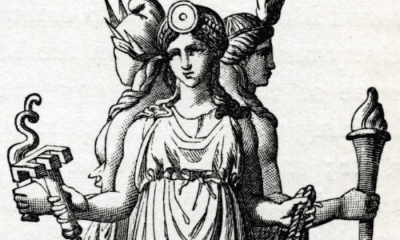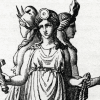Greek
Was the Griffin a Bird from Greek Mythology?
Half-lion, half-bird, the griffin is one of the most recognizable legendary animals of the ancient world. So where did the griffin come from and what did ancient people think it represented?
Ancient mythology and legends are filled with fantastic hybrid creatures. The Sphinx, Chimera, and others are remembered in the art and mythology of cultures like ancient Greece.
Many of these creatures did not originate in Greek mythology, however. Whether as noble animals or terrible monsters, they were fire thought of long before they were mentioned by Classical Greek writers.
One of the legendary animals that came to Greece was the griffin. Its ancient origins, Greek legends, and medieval symbolism all helped carry the half-bird, half-lion creature into the modern world.
The Origins of the Griffin
Like many of the fantastic creatures that were used in medieval art and heraldry, European artists learned of the griffin from ancient Greek and Roman sources. The bird did not originally come from the Mediterranean, however.
The first images of the griffin date back to before the year 3000 BC. In ancient Egypt and Iran, they were a common element in art.
Although the earliest known example of the griffin is from Egypt, archaeologists are unsure whether it originated there or in Mesopotamia. They are found in carvings and reliefs from Iran, the Levant, Syria, and Turkey.
The Greeks likely adopted the form from one of these cultures that they came in contact with through trade. This happened early in Greek history, and griffins are found at both sites from Minoan Crete and Mycenaean Greece.
These images are all identifiable as griffins because they share common traits. For thousands of years, the griffin was a hybrid animal that combined elements of a bird and a lion.
The most typical images of griffins have the hind lings of a lion with the head and chest of an eagle. While some older animals had four lion-like legs, most images had eagle’s talons on all four legs.
The griffin usually had pronounced ears that were like those of a lion or horse but were feathered. Most had wings, although a few did not.
There were many mythological animals that were closely related to the griffin and were sometimes called by that name.
One was a wingless animal with a lion’s body and only the head of an eagle. While it was sometimes called a griffin, medieval heraldry recognized it as a different creature and called it an alke.
The Opinicus was another medieval form, usually used on coats of arms, that was similar to a griffin. It sometimes had a dragon’s head, however.
The use of the griffin in medieval heraldry is one of the reasons the mythological hybrid bird remains so well-known today.
Both the lion and the eagle, the animals whose forms were included in the griffin’s image, were symbols of royalty and power. Medieval writers, therefore, saw the griffin as the most majestic of birds and a fitting symbol for noble families and proud cities.
Artists of the Middle Ages were not the first to associate the griffin with nobility, though.
My Modern Interpretation
The ancient Greeks adopted the griffin from the Near East, where it likely already had a long history of being associated with wealth and power.
Many Mesopotamian gods had similar features to the griffin, although they often also included human heads. Similar figures are also seen often in the monument architecture and treasures of palaces and temples, although this may be due to which sites were most well preserved rather than because they were only associated with places of power.
The Sphinx, for example, combined human, lion, and eagle features. In Mesopotamian cultures, Anzu was a lion-headed storm bird.
The Greeks borrowed the image of the griffin from these cultures, but they did not associate the bird with a real place. Instead, they said that it lived alongside the legendary Aramaspian people in the East.
The Aramaspians, the Greeks believed, were a one-eyed race of men who lived in Scythia to the northeast. They constantly battled the griffins for control of a vast treasure.
A central theme in the Greek worldview was that the margins of the earth were home to vast resources. The east was rich in gold, the north was a land of tin and amber, and the south was filled with valuable spices.
These beliefs were often based on ancient trade routes. Seeing wagons of gold coming from the east, the Greeks imagined how plentiful the resource must be for so much to reach them.
Because the griffin also came from the east, it came to be associated with the riches that were brought from that direction. A story arose that the griffins were guardians of mountains of gold.
The griffins were said to dig deposits of gold out of the mountains of Scythia or, in later stories, of India. They built their nests with this gold and constantly defended them from Aramaspian thieves.
The Greeks and Romans therefore saw the griffins in a different light than they did many of the other mythological creatures in their tales. Instead of violent monsters, the griffins were seen as noble animals that defended their homes and families from attack.
This noble characterization continued into the Middle Ages, when griffins continued to be a popular motif. Their interpretation took on a tone more fitting for the Christian worldview.
The legend of the griffin guarding its nest was made into an allegory for the Church and the Christian God.
Because it combined the forms of a noble animal of the land, the lion, and a noble animal of the sky, the eagle, the griffin was taken as a symbol of Christ. It represented his combined human and divine natures.
The gold it guarded came to be seen as symbolic rather than literal. While distant lands were still seen as sources of unimaginable wealth, the Church took the griffin’s treasure to be the salvation that could be attained through Christ rather than material goods.
As a symbol, however, the griffin was still seen as a guardian of real riches as well. When the city of Genoa became an important trading center, for example, it adopted the griffin as its symbol to represent the city’s growing wealth.
Just as the griffin originated from outside of Europe, it also continued to be popular in the Near East. In the 13th-century, for example, Rumi was one of many great Persian poets to reference griffins in his works.
Through medieval and Renaissance works like these, the griffin survived into the modern world. For thousands of years it has remained a symbol of distant lands and legendary riches.
In Summary
Many modern audiences know the griffin from medieval and Renaissance images. It was popular in both heraldry and Church architecture.
Griffins are half-eagle, half-lion hybrid creatures. Although there is some variation, the popularity of the griffin made its imagery more standardized than many other legendary animals.
These images were inspired by Greek and Roman accounts of the animal, which was similarly featured in art. Although there was no specific myth regarding the griffin, it was a popular legendary creature.
The Greeks believed that the griffin lived far to the east. It used its powerful beak and talons to dig gold out of mountainsides, which it used to line its nests.
The Greeks used this legend to explain some of the riches that were imported to them from the east. The griffin itself came from eastern lands, as well.
The griffin and similar creatures were well-known in both Mesopotamian and Egyptian art. They had associations with nobility and wealth that carried over into both Greek and later European belief.



